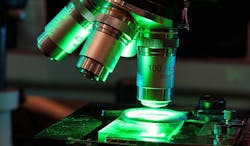Chaotic cavity laser from Yale could improve imaging quality
In response to the search for better light sources for high-speed, full-field imaging applications, Yale University (New Haven, CT) has developed a new semiconductor laser based on a chaotic cavity laser that combines the brightness of traditional lasers with the lower image corruption of light-emitting diodes (LEDs).
RELATED ARTICLE: For storing light in optical resonators, chaos proves superior to order
The new laser is described in the online edition of the Proceedings of the National Academy of Sciences. Several Yale labs and departments collaborated on the research, with contributions from scientists in applied physics, electrical and biomedical engineering, and diagnostic radiology.
"This chaotic cavity laser is a great example of basic research ultimately leading to a potentially important invention for the social good," said co-author A. Douglas Stone, the Carl A. Morse Professor and chair of applied physics, and professor of physics. "All of the foundational work was primarily motivated by a desire to understand certain classes of lasers—random and chaotic—with no known applications. Eventually, with input from other disciplines, we discovered that these lasers are uniquely suited for a wide class of problems in imaging and microscopy."
One of those problems is known as speckle, a random, grainy pattern caused by high spatial coherence that can corrupt the formation of images when traditional lasers are used. A way to avoid such distortion is by using LED light sources. The problem is, LEDs are not bright enough for high-speed imaging.
The new, electrically pumped semiconductor laser offers a different approach. It produces an intense emission, but with low spatial coherence. "For full-field imaging, the speckle contrast should be less than [approximately] 4% to avoid any disturbance for human inspection," explained Hui Cao, professor of applied physics and of physics, who is the paper's corresponding author. "As we showed in the paper, the standard edge-emitting laser produced speckle contrast of approximately 50%, while our laser has the speckle contrast of 3%. So our new laser has completely eliminated the issue of coherent artifact for full-field imaging."
Co-author Michael A. Choma, assistant professor of diagnostic radiology, pediatrics, and biomedical engineering, said laser speckle is a major barrier in the development of certain classes of clinical diagnostics that use light. "It is tremendously rewarding to work with a team of colleagues to develop speckle-free lasers," Choma said. "It also is exciting to think about the new kinds of clinical diagnostics we can develop."
The first author of the paper is Brandon Redding. Additional authors included Alexander Cerjan, Xue Huang, and Minjoo Larry Lee. Redding and Cao designed, fabricated, and tested the new laser. Lee and Huang grew the laser’s semiconductor wafer via molecular beam epitaxy, and helped in fabrication and testing. Choma aided in the design and performance criteria for the laser, provided expertise in spatial coherence and speckle in imaging, and is working with Redding to apply the laser for full-field imaging at Yale School of Medicine. Stone and Cerjan modeled the laser and analyzed its characteristics.
SOURCE: Yale University; http://news.yale.edu/2015/01/19/new-laser-could-upgrade-images-tomorrow-s-technology

Gail Overton | Senior Editor (2004-2020)
Gail has more than 30 years of engineering, marketing, product management, and editorial experience in the photonics and optical communications industry. Before joining the staff at Laser Focus World in 2004, she held many product management and product marketing roles in the fiber-optics industry, most notably at Hughes (El Segundo, CA), GTE Labs (Waltham, MA), Corning (Corning, NY), Photon Kinetics (Beaverton, OR), and Newport Corporation (Irvine, CA). During her marketing career, Gail published articles in WDM Solutions and Sensors magazine and traveled internationally to conduct product and sales training. Gail received her BS degree in physics, with an emphasis in optics, from San Diego State University in San Diego, CA in May 1986.
